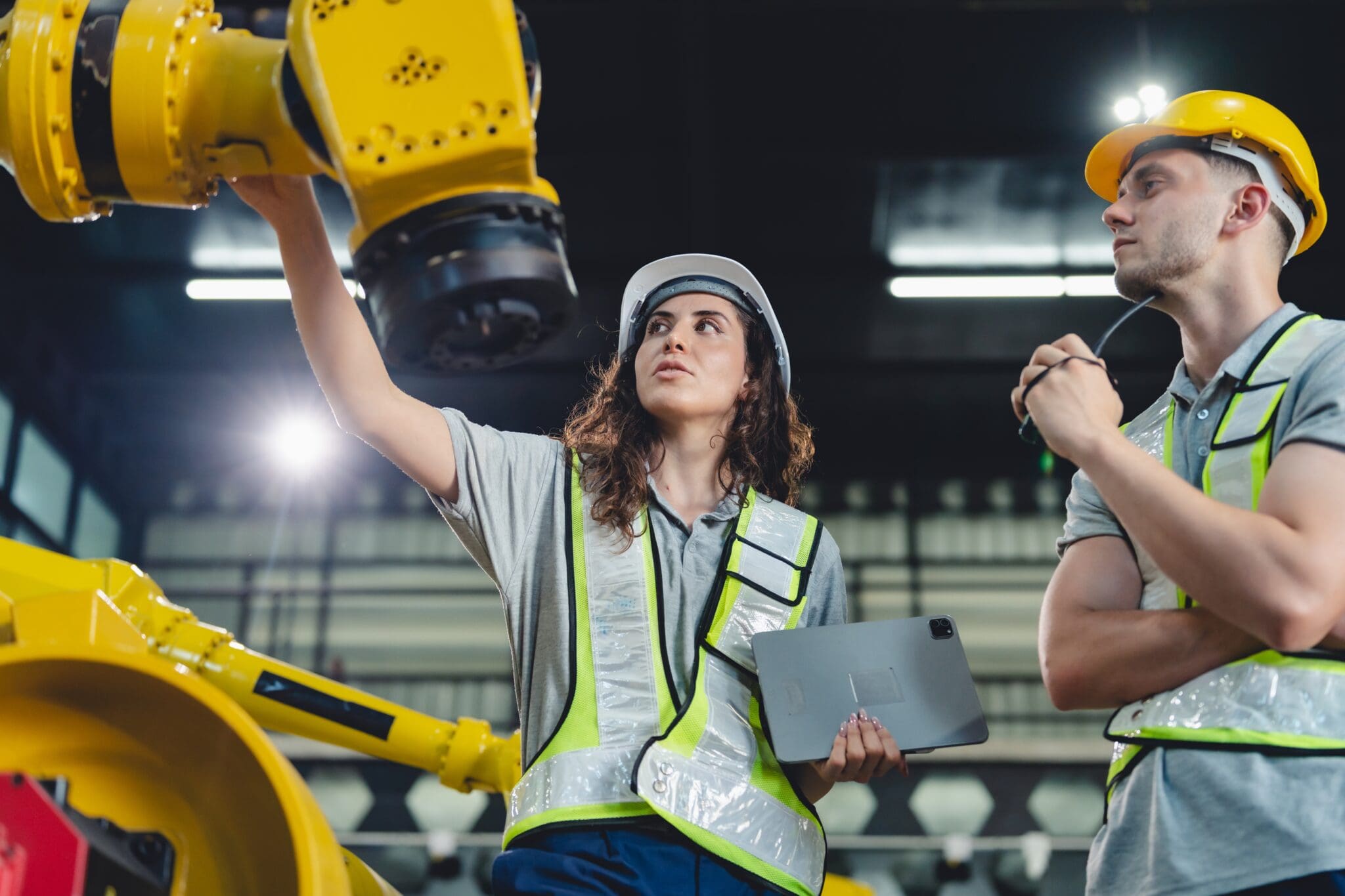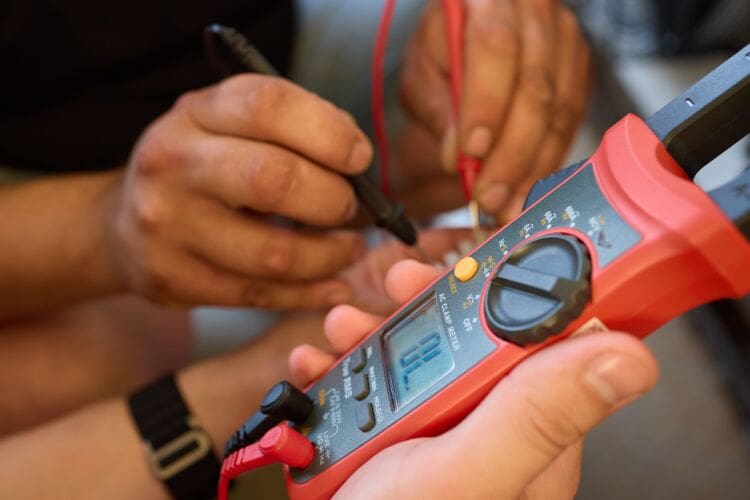In this article
This guide breaks down what PUWER means in practice and how employers can meet their legal duties to keep equipment, and people, safe at work.
What is PUWER?
The Provision and Use of Work Equipment Regulations 1998, or PUWER, are a key part of workplace health and safety legislation in the UK. PUWER applies to all employers and self-employed individuals who provide or use work equipment, and it establishes a legal requirement for ensuring that equipment is safe, well-maintained and used by people who know how.
The main aim of PUWER is to minimise the risks associated with workplace equipment, including machinery, tools, systems or mechanical devices.
It’s about proactive risk management. Employers need to think ahead, plan for equipment-related hazards and embed safety into every stage of the equipment lifecycle – from selection and installation to use, maintenance and decommissioning.
These responsibilities directly impact workplace safety, employee well-being, productivity and legal liability. Not complying with PUWER can result in enforcement action by the Health and Safety Executive (HSE), including fines, prosecutions or prohibition notices (which prohibit the use of unsafe equipment until the issue is resolved).
PUWER also serves as a blueprint for safer, smarter operations. When equipment is fit for purpose, correctly maintained and used safely, it offers opportunities for boosting productivity and minimising issues that disrupt normal operations. Employee morale also improves.

Who and what is covered by PUWER?
PUWER has a broad reach. The regulations apply to all workplaces in Great Britain and to all employers, regardless of industry, size or location.
Whether a business is a small construction firm, a large manufacturing facility, a retail outlet or a public sector organisation (such as a school or hospital), PUWER comes into play anywhere work equipment is being used. The equipment covered ranges from forklifts and conveyor belts to smaller tools like power drills, ladders and even office equipment like PCs, paper guillotines and shredders.
The regulations also cover people who are self-employed when they use equipment for work purposes. Contractors, agency workers and even temporary staff must also be considered under PUWER. If an organisation supplies or controls the use of equipment, it is responsible for ensuring that the equipment is safe and suitable, regardless of who actually operates it.
PUWER also requires employers to consider people who may be affected by the use of work equipment, like maintenance staff or other nearby workers, even if they are not the direct users. In some cases, members of the public or site visitors can be affected by the use of work equipment. A scaffolding tower on a construction site is a helpful example. It must be safe not only for those who work on it but also for others on site who might be affected if it fails or is misused.
Note that the armed forces are exempt from PUWER regulations, as are domestic workers using equipment at home – unless they’re self-employed or employed by a contractor supplying the equipment.
Selecting suitable work equipment
Under PUWER, employers should ensure that any equipment provided for use at work is suitable for its intended purpose.
But how can suitability be determined? You’ll need to consider a wide range of factors, including:
- The physical environment in which the equipment will be used
- The specific tasks it will perform
- The characteristics and skill levels of the users
- Potential hazards associated with its use
For example, a piece of machinery that operates perfectly well in a clean, dry warehouse may be unsuitable in a damp, outdoor construction site. Similarly, equipment with small, fiddly controls may not be a good fit for operators wearing gloves or those with reduced dexterity.
The law also requires that new equipment meets recognised safety standards. Employers should look for compliance with UKCA or CE marking, and wherever possible, select equipment that includes built-in safety features such as guards, interlocks, emergency stop buttons and fail-safe mechanisms. These features improve safety and reduce the likelihood of human error or misuse.
Consulting employees or safety reps when choosing equipment can offer real value. The people using the tools day to day often know what works and what causes problems. Their insight can help avoid costly mistakes and make sure the equipment is genuinely fit for purpose.
Risk assessment for equipment use
Don’t assume that equipment is safe because it’s new or because similar models have been used in the past. Every piece of work equipment carries its own unique risks, and those risks must be systematically assessed and controlled before use.
Failure to carry out an adequate risk assessment can leave employers exposed to enforcement action and, more importantly, increases the risk of preventable accidents.
Identifying hazards
A risk assessment under PUWER should begin by identifying all foreseeable hazards associated with the equipment.
Consider the following risk categories and examples:
- Mechanical hazards – entanglement, crushing, shearing, impact
- Electrical hazards – exposed wires, faulty insulation
- Ergonomic hazards – poor posture, repetitive strain
- Environmental factors – vibration, noise, extreme temperatures
Who could be harmed?
Next, identify who could be harmed by these hazards.
The equipment operator is at risk, but so is anyone who might be involved in loading, unloading, cleaning or maintaining the equipment. Even bystanders can be at risk if the equipment operates in a shared space or has moving parts that extend beyond the main work area.
Evaluating risks and applying controls
Evaluate the risk in terms of likelihood and severity. Implement controls to either eliminate the risk or reduce it to an acceptable level. These controls might include engineering measures (like installing guards), administrative measures (such as rotating staff or restricting access) and personal protective equipment (PPE).
Record-keeping and review
Record and regularly review risk assessments. Update them whenever there is a significant change – such as when equipment is relocated, modified or involved in an incident.
Maintenance, inspection and testing obligations
Once equipment is in use, employers have an ongoing responsibility to ensure it remains in a safe and serviceable condition.
Maintenance
Maintenance involves putting a structured, proactive programme in place to prevent equipment from deteriorating – which might involve things like gradual wear of moving parts, corrosion, loosening of fittings or build-up of debris that can reduce performance or make the equipment unsafe. This is especially important for equipment that is subject to high use, operates under demanding conditions or poses significant risk if it fails.
Routine maintenance tasks might include:
- Cleaning
- Lubricating
- Tightening connections
- Checking for signs of wear and tear
Employers must also plan for more in-depth servicing at set intervals. These may be based on the manufacturer’s guidance, operating hours or conditions of use. For example, a hydraulic press may require hydraulic fluid checks weekly, seal replacements every six months and a full service annually.
Inspections
Inspections can range from informal visual checks by operators before each use to formal inspections by a qualified technician.
The type and frequency of inspections should reflect the level of risk. For example, equipment with moving parts, electrical components or high-speed operation will typically require more frequent and thorough checks than low-risk items.
Testing
Equipment failure can lead to a team member being seriously injured. That’s why testing is so important.
A programme of testing might include electrical safety testing, pressure testing or structural integrity assessments. Equipment that has been altered, damaged or subjected to abnormal conditions must be retested before it can be used again.
Record-keeping
Keep records of all maintenance, inspection and testing activities. These documents help show that responsibilities are being met, make it easier to plan future servicing and highlight recurring issues or patterns that might point to bigger problems beneath the surface.
Ensuring competence: Training and instruction
Providing equipment to employees is only safe if they know how to use it correctly. Competence is a powerful tool for preventing accidents and keeping operations running smoothly.
Under PUWER, employers must ensure that all individuals who use or maintain work equipment are competent. Competence means having the necessary knowledge, skills, training and experience to perform the task safely and effectively.
Effective training should begin with a structured induction for new employees or those new to specific equipment. It should cover:
- The equipment’s purpose
- How to operate it safely
- Associated risks
- Required safety measures
- What to do in an emergency
For complex equipment, hands-on training with supervision is essential, and competency should be verified through testing or certification.
Don’t treat staff training as a one-time task. As equipment is upgraded, procedures change or incidents occur, refresher training must be provided to ensure continued safe use. It’s just as important to check in regularly on how staff are doing. Managers should watch for any unsafe habits and step in early to offer guidance and support when things start to drift from the right way of working.
Written instructions and accessible manuals play a key role in reinforcing training. They should be written in clear, plain language, and, where necessary, translated into other languages used by staff.
Visual aids (diagrams, posters and videos) can cement understanding, particularly for staff members with limited literacy or language barriers.

Safe systems of work and operating procedures
Safe systems of work describe how equipment should be used in practice, within the workplace’s specific context. They integrate physical controls, administrative processes and human factors into a coherent, repeatable method that protects everyone involved.
For example, a safe system for operating a table saw would include steps for inspecting the blade before use, wearing appropriate PPE, ensuring guards are in place, using push sticks for small pieces and shutting down the machine before clearing jams. It might also include requirements for having another worker present, prohibiting use by untrained staff and setting a time limit on operation to reduce fatigue.
Document safe systems in writing, review them regularly and update them when circumstances change. They must be communicated effectively to all relevant staff and, where applicable, incorporated into training programmes. Supervisors play a key role in enforcing these systems. They should identify breaches and take corrective action.
Non-routine tasks, like maintenance, cleaning or setup, deserve extra care. These are often high-risk activities that require specific procedures, such as isolation and lock-out/tag-out protocols.
Finally, everyone must know what to do in an emergency – how to stop the equipment quickly, shut it down safely or call for help. These procedures should be clearly explained and regularly practised.
Marking, warning signs and information
PUWER mandates that equipment must be marked with appropriate safety information. These markings and signs help users understand how to operate equipment safely and avoid hazards. Providing adequate information reinforces awareness, supports safe decision-making and ensures that critical knowledge is never out of reach when it’s needed most.
All equipment should display clear labels indicating its purpose, limitations and any specific safety precautions.
For example, a portable electrical tool might have a label stating “230V Only – Do Not Use Outdoors”. Where applicable, signs should indicate the direction of moving parts, pinch points or areas that should not be touched.
Warning signs – such as high voltage symbols, moving blade icons or PPE reminders – must be clearly visible. They should be durable, meaning they won’t deteriorate in the working environment. For example, labels shouldn’t fade or peel off. Signs should be located where the risk exists – not, for example, in another room.
Colour coding and pictograms, in line with the Health and Safety (Safety Signs and Signals) Regulations 1996, can help overcome language barriers and support instant recognition.
Instructional information, such as operating sequences or emergency shutoff steps, should also be posted near equipment. Examples include laminated guides, wall charts or screen-based prompts on digital systems.
Where equipment is modified or repurposed, all signage must be updated to reflect the new configuration.
Record-keeping requirements
Maintaining accurate and up-to-date records helps employers demonstrate compliance, track performance, identify trends and get ahead by planning preventative actions. It also provides crucial documentation if an HSE inspection or incident investigation take place.
At a minimum, maintain a detailed inventory of all work equipment. This should include:
- Serial numbers
- Specifications
- Assigned locations
- Purchase dates
- Warranty information
- Initial safety checks
Inspection logs must be kept for routine user checks and formal technical inspections. These logs should detail:
- The date of the inspection
- The name and job title of the person who performed the inspection
- The equipment type and model
- A unique identification number or mark
- The equipment’s usual operating or storage location
- What was examined
- A description of any defects or issues found
- Details of any corrective actions taken or planned
- The person or department the issues were reported to
- The date any repairs or remedial actions were completed
Maintenance records should be similarly detailed, covering:
- Servicing schedules
- Parts replacements
- Corrective actions
- Who performed the work
- Any defects identified and rectified
Training records are equally important. Employers must be able to demonstrate:
- Who has been trained on what equipment
- When the training occurred
- What topics were covered
- Whether competency was assessed
- Information about refresher training or remedial instruction following an incident or equipment change
In high-risk environments – and in large companies – digital asset management systems can provide a more efficient and reliable method for record keeping. However, paper-based systems are still acceptable, but they must be well-organised and easily accessible.
Regardless of the format, records must be kept securely and retained for as long as necessary to meet legal or operational needs.
Dealing with non-compliance and defects
Even if your organisation has the most robust safety systems in place, people can still make mistakes – and machines can fail. Treating defects and non-compliance as learning opportunities rather than punishments creates a safer and more responsive workplace culture.
When defects or non-compliance are discovered, swift and decisive action prevents harm and ensures that legal obligations are met. PUWER requires that any equipment found to be unsafe or defective must be taken out of service immediately and not used again until it has been repaired, tested and deemed safe.
Employers should have a simple system in place for reporting equipment faults, so staff can raise concerns quickly. This might be a checklist with a defect tick-box, a digital app or a paper logbook – whatever works best for the team. Once a problem is flagged, it should be followed up straight away, with clear steps for checking what’s wrong, arranging repairs and keeping staff in the loop.
An internal investigation may be needed if there’s a case of serious non-compliance, such as missing guards, unauthorised modifications or evidence of misuse. This should aim to establish the root cause; for example, inadequate training, poor maintenance or a failure of supervision. Where necessary, disciplinary or procedural actions should be taken, and the findings used to prevent the incident from happening again.
You should also be prepared for external enforcement. If the HSE identifies a PUWER breach, they may issue an improvement notice (requiring action within a set timeframe) or a prohibition notice. Fines and prosecutions can follow if the breach is severe or if previous warnings were ignored.
Integrating PUWER with LOLER and other H&S duties
PUWER sits within a wider framework of health and safety law, and it works best when joined up with other regulations.
Here are some common areas of overlap:
- The Lifting Operations and Lifting Equipment Regulations 1998 (LOLER) – Apply to lifting equipment such as cranes, hoists and forklift trucks. While LOLER governs the specific risks associated with lifting, PUWER covers the broader suitability, maintenance and training responsibilities for the same equipment.
- The Control of Substances Hazardous to Health Regulations (COSHH) – Apply when equipment exposes workers to harmful chemicals or emissions. Equipment used to spray, mix or handle chemicals must be assessed under both PUWER and COSHH to ensure that both machinery safety and exposure risks are controlled.
- The Electricity at Work Regulations 1989 – Require safe installation and use of electrical equipment.
- The Management of Health and Safety at Work Regulations 1999 – Mandate broader risk assessments and control measures.
Instead of tackling each regulation separately, aim to create an integrated safety management system. This approach ensures consistency, avoids doubling up on effort and makes better use of time, people and resources.
Preparing for HSE inspections and audits
HSE inspections are a fact of life for most organisations and can occur without warning. Being prepared not only reduces stress but also significantly increases the chances of a positive outcome.
Inspectors will typically look at:
- The condition of equipment
- Safety features
- The clarity of operating instructions
- Whether risk assessments and maintenance records are in place and up to date
Start preparing by conducting internal audits of PUWER compliance. This means walking the floor, inspecting equipment, reviewing documentation and speaking to staff about their understanding of safe use. Address any gaps promptly, whether through updated procedures, additional training or equipment upgrades.
Key documents – equipment inventories, maintenance logs, inspection reports, training records, risk assessments and safe working procedures – should be easy to find and well-organised. Where older equipment is still in use, you should be able to justify its continued use through evidence of good maintenance, risk controls and suitability assessments.
Staff should also be briefed on what to expect during an inspection and encouraged to speak openly with inspectors. When people feel confident and involved, it shows that the organisation takes safety seriously and has nothing to hide.

Common pitfalls and how to avoid them
PUWER’s requirements are clear, but many employers still fall into common traps.
- Assuming that compliance is only necessary for large or high-risk equipment – Even simple hand-held tools or small appliances can cause serious injuries if misused or poorly maintained.
- Neglecting refresher training – Initial training is not enough, especially as procedures evolve or equipment is updated.
- Not updating risk assessments – Keep risk assessments up to date in response to workplace changes, such as moving equipment to a new area or modifying its function.
- Focussing too heavily on reactive maintenance – Don’t wait for something to go wrong before acting. A better approach is preventive maintenance based on schedules, usage data and historical patterns. This not only improves safety but reduces costs and downtime.
- Poor communication – Staff often fail to report faults or misuse if they fear blame or think their concerns won’t be taken seriously. Promoting a no-blame reporting culture, backed by strong management follow-through, is essential for ongoing safety.
Conclusion and further resources
PUWER is a practical framework for ensuring that work equipment is safe, efficient and fit for purpose. When they understand and implement PUWER’s duties, employers can reduce accidents, avoid enforcement action and support employee safety and well-being.
Fulfilling these responsibilities means taking a joined-up, proactive approach – selecting the right equipment, conducting detailed risk assessments, implementing safe systems of work, ensuring regular maintenance, providing effective training and maintaining thorough documentation. When PUWER is aligned with other key regulations, such as LOLER and COSHH, it supports legal compliance while also improving efficiency and safety across the organisation.
The following resources support employers with PUWER compliance:
- The HSE’s PUWER overview and website: www.hse.gov.uk
- Institution of Occupational Safety and Health (IOSH) resources
- Industry-specific codes and manufacturer manuals
- British Standards on equipment safety and maintenance






